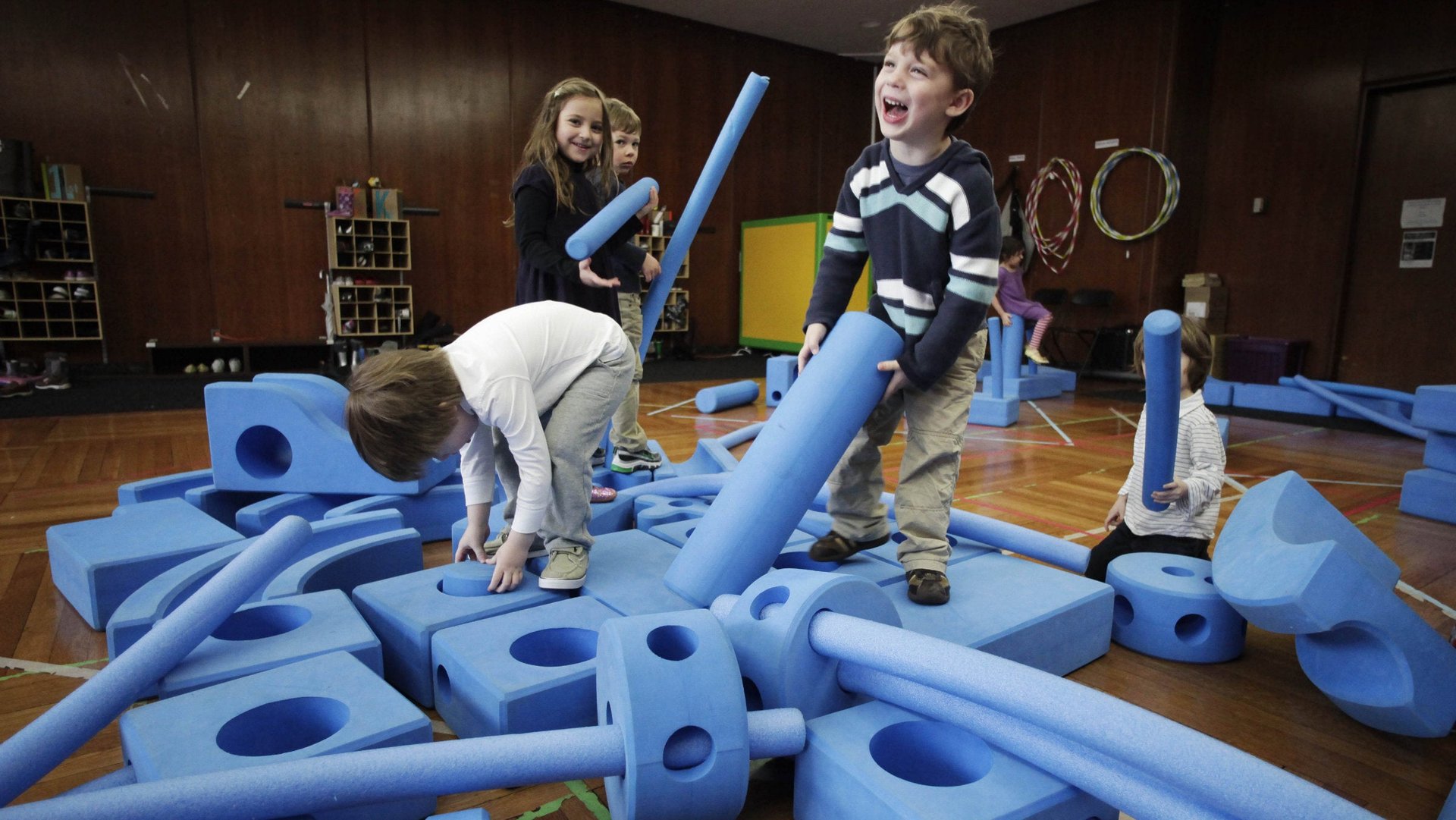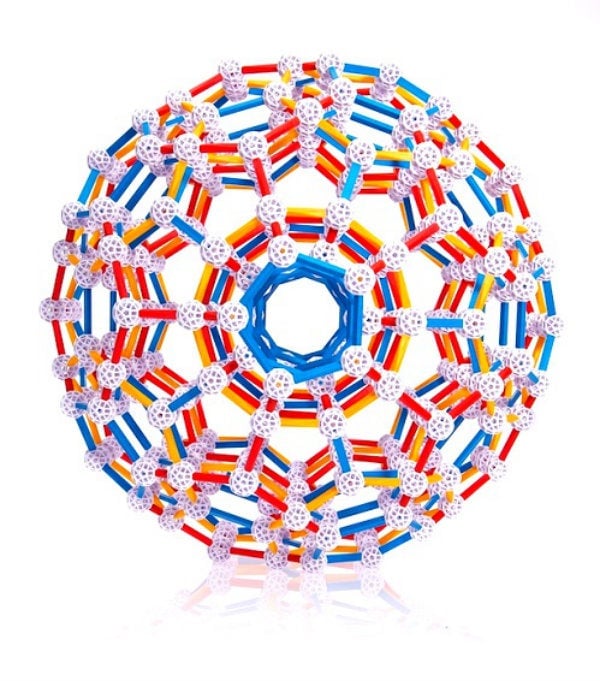Parents are buying their kids all the wrong toys
The highlight of my son’s speech therapy was always the bag of toys. Years ago, when he was a toddler and the therapist came to our house, he’d wait patiently as she took out one toy at a time and used each to help build language skills. Anxious to boost his progress, I watched her work and wrote down the name of her “tools.” I would then run to Toys R Us—and almost always, I would walk out empty-handed.


The highlight of my son’s speech therapy was always the bag of toys. Years ago, when he was a toddler and the therapist came to our house, he’d wait patiently as she took out one toy at a time and used each to help build language skills. Anxious to boost his progress, I watched her work and wrote down the name of her “tools.” I would then run to Toys R Us—and almost always, I would walk out empty-handed.
Toy stores, it turns out, are the worst place to buy toys. The educational aisle is even more upsetting, filled with battery-operated toys with cartridges, sounds, and styluses. What toy stores (and parents) need to understand better is that for a product to be an effective learning tool, the child has to be able to use it to make inquiries and attempt to answer them. However, in the case of educational toys, it’s the machine that is asking all the questions.
Parents’ play, too, must change. For starters, they need to get on the floor. All too often, parents use toys as babysitters. Sit the kids down with something and walk away to check email or do the dishes. They expect the toy to engage their child to the point where the child is mesmerized. “She can’t put it down,” they’ll say to describe the successful toys. There is no shame in trying to amaze and astonish when kids open their gifts, but if we want to turn our toy purchases into educational investments, then we need to get involved and stay involved. We have to play with them. It’s as simple as that.
It’s crucial that we get play right. For society. For the economy. For competitiveness. For the workplace.
Multitasking early
Instead of focusing all their attention on machines that speak, early learners actually need to practice so-called joint attention skills. These skills are going to directly impact their ability to learn in a classroom, to speak up in a meeting, to make sense of conflicting thoughts and points of view. Here’s an example from a typical office setting: When the director of my division is reading a report to my group, I am thinking about the report. When he asks a question, I shift my attention to my supervisor, who begins to answer the question. I am then thinking of what he said and also thinking of what others think about what he said. Then, I remember something that tells me that my supervisor is wrong. I look up and meet eyes with another colleague who is already looking at me; she knows what I know. We are both thinking and communicating with our eyes but neither of us have said a word. The educational toys I’ve described couldn’t possibly help a child develop the skill of joint attention. The idea that a machine, asking you a series of questions, can teach and simulate being an active member of a workplace or classroom is ridiculous. It’s more like a test or a game show.
The good news is that there are many toys and games that are great at this. And there is still more that parents can do—even without these tools. When I used to read to my son, I never discussed the book with him. When I bought my son toys, I would leave them in front of him and walked away thinking that my part was done. If my son had trouble, I would often tell him that someone his age should be able to do those things, even though the packaging just gives a vague estimation on appropriate ages. A rating of 4+ doesn’t show a breakdown of what a 4-year-old can do with a toy versus what a 6-year-old can do with it.
Toys are not us
With the help of the speech therapist and other therapists I’ve met, I’ve learned that the best places to buy good toys are in specialty toy retailers and therapeutic product retailers. What is a “specialty toy”? The American Specialty Toy Retailing Association (ASTRA), the largest association serving the specialty toy industry, defines specialty toys as toys designed with a focus on what the child can do, rather than what the toy can do.
I think the term “special” is fitting because, as I’ve mentioned, what is offered in “mainstream” large toy retailers is very disappointing. Take the blocks selection, for example. Blocks are the tools that kids use to do “constructive play” something that is seen from ages 3-6. In these stores, I see scores of various block offerings but they are more focused on wowing parents with “features” such as letters, sounds, plastic cubes that encase animals or mirrors, wooden cubes have something on each side (letters, numbers, animals, textures).
Think of a 3-year-old playing with blocks. Why would she need such distractions? It’s challenging enough to just stack them so that they don’t fall (or fall in an entertaining way). We want to encourage kids to build with blocks because they will develop strength in their core trunk, shoulder, and arm muscles. These muscles will support better handwriting and even paying attention in class. Additionally, the more they build, the more they will understand about the forces of gravity and structural integrity. Of equal importance, we want to encourage kids to build with blocks so that they can make something. It’s easier to see your building, your creation, if your blocks are plain.
Some of the best blocks—without bells and whistles—for preschoolers are Lauri Tall Stacker Pegs, which are found at Red Hen Toys, an online retailer based in Michigan. Lauri pegs are wonderful for pretend play, fine motor strengthening, and pattern recognition. I also love these 1-inch Color Cubes at Different Roads to Learning, a New York-based online store that caters to the special needs community. The unique size of the beautifully stained (not painted) cubes supports the 3-Jaw-Chuck—the grasp pattern that emerges as children learn to hold things with an opposed thumb and the index and middle fingers—the most efficient for handwriting. You can even buy corresponding pattern cards that remind me of the block portion on IQ tests.
Ask not what your toy can do for you
As parents, we mistakenly start with the most advanced activity that can be done with a toy and don’t allow our children to explore their toys intuitively. This is a big mistake. Parents need to do what that speech therapist did for my son when he was a toddler. She got down on the floor and she engaged him. She never overwhelmed him with too many pieces. She modeled good speech by spending time with him and describing what he did and what she did. She provided “just right” challenges whenever she saw that he was ready for more. Most importantly, she was patient and never judgmental. Whatever the activity was, she would never do it for him. If he was slow to do it then she would wait, even if it was a little awkward.
There are so many wonderful building toys that encourage inquiry, experimentation, and social interaction. Playing with friends and parents with these toys can help children build joint attention skills. I especially love geometrical building toys as they provide children with a sense of symmetry, pattern recognition, and proportion, all through play. For younger elementary ages, I like Magformers,Geomag, SmartMax, all of which are magnetic and can be purchased with accessories such as LED lights, glow-in-the-dark pieces, wheels, and propellers. These add-ons can encourage children to experiment and pretend play.
Non-magnetic geometric toys are also just as fun. Again, I never get to see these in my local big box toy retailer. Zometool and Reptangles are two building toys that snap pieces together to create 2D and 3D shapes. (Both are available at Fat Brain Toys, an excellent site selling toys and games from all over the world.) Importantly, the toys help children build and relate to concepts in nature: snowflakes, carbon molecules, and even DNA. Reptangles’ pieces themselves are an excellent model of tessellations and mirror the work of the great artist, M.C. Escher.

Kaleidograph is another great geometry toy that is just a collection of die-cut color cards that reflect the natural geometry of crystals and flowers. It will make any math teacher or geek parent swoon. On a bus ride with my son’s kindergarten class, I handed out a few cards to each of my child’s friends all were of different 3-point symmetrical rotational shapes. As the children stacked the cards, they made unique designs and were able to keep shuffling until they found the design they liked best. They were amazed with the creations they made; “Look at me!” they said throughout the ride, not realizing they were practicing their joint attention skills.
How to fight boredom
To be sure, there are some mainstream toys, such as Lego and K’nex, that allow children to make impressive creations and can even lead children into learning about machines and robotics. I especially love the K’nex Education Sets that explore science and math. This year, I’ve also met my inner Lego as I convinced my kids to spend my money in the “pick-a-brick” section in the store. The Lego Mindstorms EV3, an open-ended robotics platform for kids was introduced this year and is on the wish list; it will likely still be a wish until next year because we need time to save up for the $350 price tag.
Sometimes, we avoid buying open-ended toys because we see our children stop playing with them after the novelty has worn off. The most frequent question from readers about a toy: “Does it have staying power?” Let’s change our thinking here, too. If children stop playing with an item, parents may think that the failure lies with the toy. Really, no one is at fault. Perhaps the child is just not feeling inspired. They’re human and we can’t expect them to be creative every minute of the day. When children, and even adults feel this uninspired, they want to just buy more and more to fill the void—again and again.
When I see that my children are ignoring their open-ended toys, I just start playing with them by myself. I don’t even invite them to join me—but they always do. They’ll sit beside me and say, “Hey Mom, look what I made!” The inspiration returns, without any cajoling or direction. All I had to do was sit down and play first. It works every time.